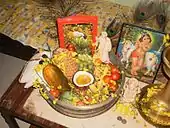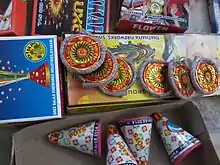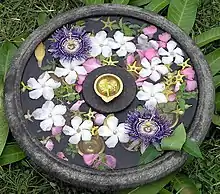Vishu
Vishu (Malayalam: Viṣu, Tulu: Bisu) is a Hindu festival celebrated in the Indian state of Kerala, Tulu Nadu region in Karnataka, Mahé district of Union Territory of Pondicherry, neighbouring areas of Tamil Nadu and their diaspora communities.[1][2][3][4][5] The festival marks the first day of Medam, the ninth month in the solar calendar followed in Kerala.[6] It therefore always falls in the middle of April in the Gregorian calendar on 14th or 15th April every year.[7][8][9][10]
| Vishu | |
|---|---|
 A traditional Vishu kani setting with auspicious items. | |
| Official name | Vishu |
| Observed by | Malayali Hindus (Kerala Hindus), Tuluvas |
| Type | Religious |
| Observances | Vishu Kani, Vishukkaineetam, Vishukkanji, Kani konna, Vishupadakkam (fireworks) |
| Begins | dawn |
| Ends | after 24 hours |
| Date | First day of the month of Meṭam(Aries) in the Malayalam calendar |
| 2020 date | Tue, 14 April |
| 2021 date | Wed, 14 April |
| Related to | South and Southeast Asian solar New Year |
| Part of a series on |
| Hinduism |
|---|
 |
|
The festival is notable for its solemnity and the general lack of pomp[6][11] The festival is marked by family time, preparing colourful auspicious items and viewing these as the first thing on the Vishu day( Vishukkani). In particular, Malayalees seek to view the golden blossoms of the Indian laburnum (Kani Konna), money or silver items, cloth(pattu), mirror, rice and other harvest products.[6][11][12] The day also attracts firework play by children,[6][13] wearing new clothes (Puthukodi) and the eating a special meal called Sadhya, which is a mix of salty, sweet, sour and bitter items.[12] The Vishu is celebrated by giving money to younger ones [vishukai neetam], it is a blessing from the family by exchanging the money.
The Vishu arrangement typically includes an image of Vishnu, typically in the form of Krishna. People also visit temples like Sabarimala Ayyappan Temple or Guruvayur Sree Krishna temple or Kulathupuzha Sree BaalaShastha Temple to have a 'Vishukkani Kazhcha' (viewing) in the early hours of the day.[14]
Etymology and origin
Vishu, from Sanskrit-Malayalam Viṣuvam, literally means 'equal',[15] and it connoted to the celebration of spring equinox in the past.[6] The spring equinox however occurs 24 days before the day of Vishu, on March 21/Meenam 7, due to precession of equinoxes.
Religious significance
The Vishu marks the first day of the astronomical year and hence Lord Vishnu and his incarnation Lord Krishna are worshipped on the day of Vishu, as Lord Vishnu is considered as the God of Time. It was on this day that Lord Krishna killed the demon Narakasura and because of this Krishna idols are kept in the Vishu kani.[16]
The Vishu has been celebrated in Kerala from the reign of Sthanu Ravi since 844 AD .[17]
Practices
Vishukkani

.jpg.webp)
The Malayalam word "kani" literally means "that which is seen first", so "Vishukkani" means "that which is seen first on Vishu". The traditional belief is that one's future is a function of what one experiences, that the new year will be better if one views auspicious joyful things as the first thing on Vishu. Therefore, Malayali's spend the day before preparing a setting, usually a tray, of auspicious items. This setting is the first thing they see when they wake up on the Vishu day.[11][14]
The Vishukkani setting consists of items such as[12] rice, golden lemon, golden cucumber, coconut cut open, jack fruit, kanmashi Kajal, betel leaves, arecanut, metal mirror (Vaalkannadi), golden yellow Konna flowers (Cassia fistula) which bloom in the season of Vishu, holy Hindu texts, coins or currency notes, oil lamp (nilavilakku), and an image of the Hindu god Vishnu.[11] Mirror in Vishukani is a symbol of seeing yourself as a part of abundance you see in the form of Kani.
The tradition has been that one of the members of the house, typically the mom or elderly person lights up the lamps at dawn, then goes to each member of her family one by one, blindfolds and wakes each one up, walks them to the front of the setting. She then releases the blindfold so one can see the setting, and then greets the Vishu day.[11][14]
Vishu Sadhya

The Sadhya (feast) is a major part of all Kerala festivals. However, special dishes called Vishu Kanji, Thoran and Vishu katta are more important on the new year day. The Kanji is made of rice, coconut milk and spices. Vishu katta is a delicacy prepared from freshly harvested rice powder and coconut milk served with jaggery.[12] For Thoran, the side dish, there are also mandatory ingredients. Other important Vishu delicacies include Veppampoorasam (a bitter preparation of neem) and Mampazhappulissery (a sour or ripe mango soup)[18] Even temple offerings called bewu bella, include a mix of sweet jaggery, bitter neem, and other flavors.[11]
The mixing of sweet, salty, sour, bitter and astringent flavors for the new year Vishu meal is similar to the pacchadi food prepared on new year day such as Ugadi by Hindus in Karnataka, Telangana and Andhra Pradesh in the Indian subcontinent. These traditional festive recipes, that combine different flavors, are a symbolic reminder that one must expect all flavors of experiences in the coming new year, that no event or episode is wholly sweet or bitter, experiences are transitory and ephemeral, and to make the most from them.[19]
Vishu Padakkam

The word 'Padakkam' in Malayalam means firecrackers.Firecrackers are burst during Vishu the same way north Indians burst firecrackers during Diwali.[20]
Vishukonna

Konna (Cassia fistula), commonly known as golden shower is the flower of the Vishu festival.
Other customs


The tradition of buying of new clothes for the occasion of Vishu is called Puthukodi or Vishukodi. There is also a popular tradition of elders giving money to younger ones or dependents of the family. This is called Vishukkaineetam.[12][13] Another tradition is of giving alms and contributing to community charity.[21] Children enjoy setting off firecrackers.[12]
Pathamudayam
Pathamudayam is Celebrates on the 10th day of Medam Month in Malayalam Era and 10th day after Vishu. According to the tradition, ‘Pathamudayam’ is the day when the sun is most powerful and astrological science support the believe.To symbolise the ten sunrises from Vishu, traditional oil lamps with 10 wicks are lit r every house.[22]
Related holidays
Vishu, which used to be the Kerala new year day, is celebrated elsewhere but called by other names. It is called Vaisakhi by Hindus and Sikhs in north and central India, which marks the solar new year, and Tamil New Year day called Puthandu.[23][24][25] The new year day on or next to 14 April every year, is also the new year for many Buddhist communities in parts of southeast Asia such as Myanmar and Cambodia, likely an influence of their shared culture in the 1st millennium CE.[25]
However, this is not the universal new year for all Hindus. For some, such as those in and near Gujarat, the new year festivities coincide with the five day Diwali festival. For many others, the new year falls on Ugadi and Gudi Padwa, which falls a few weeks earlier.[25]
See also
| Wikimedia Commons has media related to Vishu. |
- Indian New Year
- Bisu Parba
- Gudhi Padwa
- Onam
- Bihu
- Vaisakhi
- Pohela Boishakh
- Tamil Puthandu
- Songkran, a Buddhist New Year festival around 14 April, celebrated in Thailand, Cambodia, Laos etc.
- Ugadi, New year of many people of Karnataka, Telangana and Andhra Pradesh.
References
- "Culture Heritage". Retrieved 14 April 2020.
- "Wish you all a Very Happy VISHU and a Prosperous New Year". Retrieved 10 April 2020.
- Crump, William D. (2014). Encyclopedia of New Year's Holidays Worldwide. McFarland. p. 116. ISBN 978-0-7864-9545-0.
- Dalal, Roshen (2010). Hinduism: An Alphabetical Guide. Penguin Books. pp. 135–137. ISBN 978-0-14-341421-6.
- Roy, Christian (2005). Traditional Festivals: A Multicultural Encyclopedia. ABC-CLIO. pp. 479–481. ISBN 978-1-57607-089-5.
- Major festivals of Kerala, Government of Kerala (2016)
- "Major festivals - Vishu". Official Website of Government of Kerala. Retrieved 17 September 2013.
- Singh, Kumar Suresh (2002). People of India, Volume 27, Part 1. Anthropological Survey of India. p. 479. ISBN 978-81-85938-99-8.
- Melton, J. Gordon (2011). Religious Celebrations: An Encyclopedia of Holidays, Festivals, Solemn Observances, and Spiritual Commemorations. ABC-CLIO. p. 633. ISBN 978-1-59884-206-7.
- "2017 Official Central Government Holiday Calendar" (PDF). Government of India. Retrieved 4 March 2017.
- Jagannathan, Maithily (2005). South Indian State Festivals and Traditions. Abhinav Publications. pp. 76–77. ISBN 978-81-7017-415-8.
- "When the Laburnum blooms". The Hindu. 14 April 2011. Retrieved 27 September 2013.
- "City celebrates Vishu". The Hindu. 16 April 2010. Retrieved 27 September 2013.
- Dalal, Roshen (2010). Hinduism: An Alphabetical Guide. Penguin Books. p. 461. ISBN 978-0-14-341421-6.
- http://spokensanskrit.org/index.php?mode=3&script=hk&tran_input=%E0%A4%B5%E0%A4%BF%E0%A4%B7%E0%A5%81%E0%A4%B5&direct=au&anz=100
- "Vishu 2017: History, legends, practices and all you need to know". Retrieved 12 April 2020.
- "Vishu 2017: History, legends, practices and all you need to know". Retrieved 12 April 2020.
- "Vishu delicacies". The Hindu. 9 April 2009. Retrieved 27 September 2013.
- Narayanan, Vasudha (1999). "Y51K and Still Counting: Some Hindu Views of Time". Journal of Hindu-Christian Studies. Butler University. 12 (1): 17–18. doi:10.7825/2164-6279.1205.
- "Vishu 2017: History, legends, practices and all you need to know". Retrieved 10 April 2020.
- Roy, Christian (2005). Traditional Festivals: A Multicultural Encyclopedia. ABC-CLIO. pp. 479–480. ISBN 978-1-57607-089-5.
- https://www.newindianexpress.com/cities/kochi/2013/apr/24/pathamudayam-celebrated-470999.html
- "BBC - Religion: Hinduism - Vaisakhi". BBC. Retrieved 22 January 2012.
- Crump, William D. (2014), Encyclopedia of New Year's Holidays Worldwide, MacFarland, page 114
- Pechilis, Karen; Raj, Selva J. (2013). South Asian Religions: Tradition and Today. Routledge. pp. 48–49. ISBN 978-0-415-44851-2.